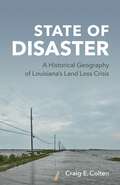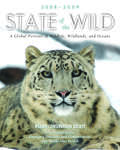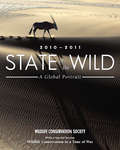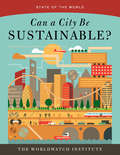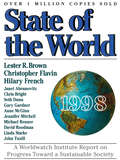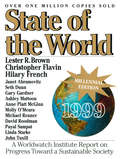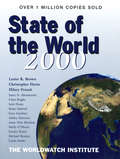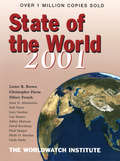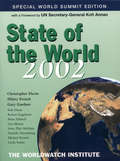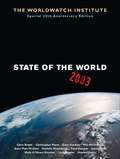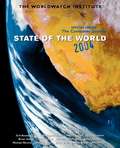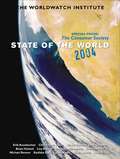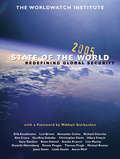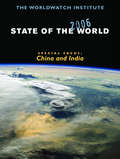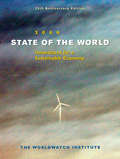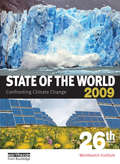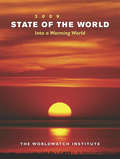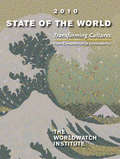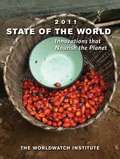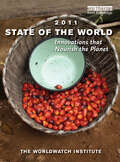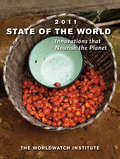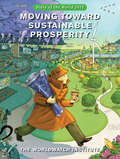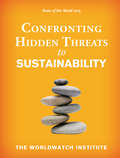- Table View
- List View
State of Disaster: A Historical Geography of Louisiana’s Land Loss Crisis
by Craig E. ColtenState of Disaster: A Historical Geography of Louisiana’s Land Loss Crisis explores Louisiana’s protracted efforts to restore and protect its coastal marshes, nearly always with minimal regard for the people displaced by those efforts. As Craig E. Colten shows, the state’s coastal restoration plan seeks to protect cities and industry but sacrifices the coastal dwellers who have maintained their presence in this perilous place for centuries. This historical geography examines in turn the adaptive capacity of those living through repeated waves of calamity; the numerous disjointed environmental management regimes that contributed to the current crisis; the cartographic visualizations of land loss used to activate public coastal policy; and the phases of public input that nevertheless failed to give voice to the citizens most impacted by various environmental management strategies. In closing, Colten situates Louisiana’s experience within broader discussions of climate change and recovery from repeated crises.
State of the Wild 2008-2009: A Global Portrait of Wildlife, Wildlands, and Oceans (State of the Wild #2)
by Eva Fearn Ward WoodsState of the Wild is a biennial series that brings together international conservation experts and writers to discuss emerging issues in the conservation of wildlife and wild places. Each volume in the series combines evocative writings with a fascinating tour of conservation news highlights and vital statistics from around the world. One-third of each volume focuses on a topic of particular concern to conservationists working to protect wildlife and our last wild places. This 2008-2009 edition considers the integration of wildlife health, ecosystem health, human health, and the health of domestic animals--a "One World-One Health" approach to disease and conservation. This focus is complemented with essays clustered into sections that address other key issues--conservation of species; conservation of wild places; people, culture, and conservation; and the art and practice of conservation. Essays cover a broad range of topics, from restoring biodiversity on the prairies to mapping the state of the oceans to the conservation impacts of lawlessness and coca cultivation in Colombia. Essay contributions come from people directly involved in on-the-ground conservation efforts and offer a unique and valuable perspective on often-overlooked topics. State of the Wild's accessible approach educates a wide range of audiences while at the same time presenting leading-edge scientific overviews of hot topics in conservation. Uniquely structured with magazine-like features up front, conservation news in the middle, and essays from eminent authors and experienced scientists throughout, this landmark series is an essential addition to any environmental bookshelf.
State of the Wild 2010-2011: A Global Portrait (State of the Wild #3)
by Eva Fearn Ward WoodsState of the Wild is a biennial series that brings together international conservation experts and writers to discuss emerging issues in the conservation of wildlife and wild places. Each volume in the series combines evocative writings with a fascinating tour of conservation news highlights and vital statistics from around the world. One-third of each volume focuses on a topic of particular concern to conservationists. This 2010-2011 edition considers how destabilization and war affect wildlife and wild places. Only recently has the international community begun to appreciate the cost of conflict--simmering tension, war, and reconstruction--on the natural world. This special section examines the role that conservation plays in the context of human conflict considering issues such as, Can the work of saving wildlife and wild places help ameliorate tensions? Can conservation deepen political understanding? Can conservation help in post-conflict situations? The book's twenty essays are intermixed with poetry and beautiful photos that capture our connection to the wild. State of the Wild's accessible approach educates a wide range of audiences while at the same time presenting leading-edge scientific overviews of hot topics in conservation. Uniquely structured with magazine-like features up front, conservation news in the middle, and essays from eminent authors and experienced scientists throughout, this landmark series is an essential addition to any environmental bookshelf.
State of the World (State of the World)
by The Worldwatch The Worldwatch InstituteCities are the world's future. Today, more than half of the global population--3. 7 billion people--are urban dwellers, and that number is expected to double by 2050. There is no question that cities are growing; the only debate is over how they will grow. Will we invest in the physical and social infrastructure necessary for livable, equitable, and sustainable cities?In the latest edition of State of the World, the flagship publication of the Worldwatch Institute, experts from around the globe examine the core principles of sustainable urbanism and profile cities that are putting them into practice. State of the World first puts our current moment in context, tracing cities in the arc of human history. It also examines the basic structural elements of every city: materials and fuels; people and economics; and biodiversity. In part two, professionals working on some of the world's most inventive urban sustainability projects share their first-hand experience. Success stories come from places as diverse as Ahmedabad, India; Freiburg, Germany; and Shanghai, China. In many cases, local people are acting to improve their cities, even when national efforts are stalled. Parts three and four examine cross-cutting issues that affect the success of all cities. Topics range from the nitty-gritty of handling waste and developing public transportation to civic participation and navigating dysfunctional government. Throughout, readers discover the most pressing challenges facing communities and the most promising solutions currently being developed. The result is a snapshot of cities today and a vision for global urban sustainability tomorrow.
State of the World 1998: A Worldwatch Institute Report On Progress Toward A Sustainable Society (State of the World)
by The Worldwatch InstituteIn this fifteenth edition of State of the World, Lester R. Brown and the Worldwatch research team look at the environmental effects of continuing economic growth as the economy outgrows the earth's ecosystem. As the global economy has expanded from $5 trillion of output in 1950 to $29 trillion in 1997, its demands have crossed many of the earth's sustainable yield thresholds
State of the World 1999: A Worldwatch Institute Report On Progress Toward A Sustainable Society (State of the World)
by The Worldwatch InstituteWritten in clear and concise language, with easy-to-read charts and tables, State of the World presents a view of our changing world that we cannot afford to ignore.
State of the World 2000: A Worldwatch Institute Report On Progress Toward A Sustainable Society (State of the World)
by The Worldwatch InstituteState of the World 2000 shines a sharp light on the great challenge our civilization faces: how to use our political systems to manage the difficult and complex relationships between the global economy and the Earth's ecosystems. If we cannot build an environmentally sustainable global economy, then we have no future that anyone would desire.
State of the World 2001
by The Worldwatch InstituteFrom the thinning of the Arctic sea ice to the invasion of the mosquito-borne West Nile virus, State of the World 2001 shows how the economic boom of the last decade has damaged natural systems. The increasingly visible evidence of environmental deterioration is only the tip of a much more dangerous problem: the growing inequities in wealth and income between countries and within countries, inequities that will generate enormous social unrest and pressure for change.
State of the World 2002 (State of the World)
by The Worldwatch InstituteState of the World 2002 includes chapters on climate change, farming, toxic chemicals, sustainable tourism, population, resource conflicts and global governance
State of the World 2003 (State of the World)
by The Worldwatch InstituteThe challenges are still immense, of course, as the book also documents, but the building blocks for a historic reinvention of human civilization are now within reach.
State of the World 2004
by Linda StarkeIt focuses on consumption-one of the most central and also one of the most neglected elements in the global search for a sustainable future.
State of the World 2004: The Consumer Society (State of the World)
by The Worldwatch InstituteWith chapters on food, water, energy, the politics of consumption and redefining the good life, Worldwatch's award-winning research team asks whether a less-consumptive society is possible--and then argues that it is essential.
State of the World 2005: Redefining Global Security (State of the World)
by The Worldwatch InstituteIn State of the World 2005, Worldwatch researchers explore underlying sources of global insecurity including poverty, infectious disease, environmental degradation, and rising competition over oil and other resources. Find out why terrorism is just symptomatic of a far broader set of complex problems that require more than a military response.
State of the World 2006: China and India (State of the World #0)
by The Worldwatch InstituteState of the World 2006 provides a special focus on China and India and their impact on the world as major consumers of resources and polluters of local and global ecosystems. The report explains the critical need for both countries to "leapfrog" the technologies, policies, and even the cultures that now prevail in many western countries for the sake of global sustainability--and reports on some of the strategies that China and India are starting to implement. Besides the focus on China and India, State of the World 2006 looks at actions corporations can take to be more socially responsible; examines the potential socioeconomic, health, and environmental implications of nanoscale technologies; assesses the impacts of large-scale development of biofuels on agriculture and the environment; describes mercury sources, industrial uses, and health hazards worldwide; and provides an overview of the need to safeguard freshwater ecosystems, with examples of proven approaches in cities, villages, and farming regions around the world.
State of the World 2007: Our Urban Future (State of the World)
by The Worldwatch InstituteIn 2008, half of the Earth's population will live in urban areas, marking the first time in history that humans are an urban species. State of the World 2007: Our Urban Future examines changes in the ways cities are managed, built, and lived in that could tip the balance towards a healthier and more peaceful urban future.
State of the World 2008: Innovations for a Sustainable Economy (State of the World)
by The Worldwatch InstituteEnvironmental issues were once regarded as irrelevant to economic activity, but today they are dramatically rewriting the rules for business, investors, and consumers. Around the world, innovative responses to climate change and other environmental problems are affecting more than $100 billion in annual capital flows as pioneering entrepreneurs, organizations, and governments take steps to create the Earth's first "sustainable" global economy.
State of the World 2009: Confronting Climate Change
by Worldwatch InstituteThe year 2009 will be pivotal for Earth's climate. As scientists warn that we have only a few years to reverse the rise in greenhouse gas emissions if we are to avoid abrupt and catastrophic climate change, the world community has agreed to finalize negotiations on a new climate agreement in Copenhagen in late 2009. Intended to inject new inspiration and energy into national and international climate negotiations, this 26th edition of State of the World examines the steps we urgently need to take to prevent a global catastrophe while adapting to the now inevitable climatic shifts already set in motion. As well as the profound, long-term consequences of global warming, this volume explores the policy changes needed and the benefits that will flow from the transition to a low-carbon economy. It also includes 22 summaries on the many important issues linked to climate change, plus a Climate Change Reference Guide and Glossary. Published annually in 28 languages, State of the World is long established as the most authoritative and accessible annual guide to our progress towards a sustainable future. It is relied upon by national governments, UN agencies, development workers and law-makers for its up-to-the-minute analysis and information. Essential reading for anyone concerned with building a positive, global future.
State of the World 2009: Into a Warming World
by The Worldwatch InstituteIt's New Year's Day, 2101. Somehow, humanity survived the worst of global warming--the higher temperatures and sea levels and the more intense droughts and storms--and succeeded in stabilizing the Earth's climate. Greenhouse gas concentrations are peaking and are expected to drift downward in the 22nd century. The rise in global temperatures is slowing and the natural world is gradually healing. The social contract largely held. And humanity as a whole is better fed, healthier, and more prosperous today than it was a century ago. This scenario of an imagined future raises a key question: What must we do in the 21st century to make such a future possible, and to head off the kind of climate catastrophe that many scientists now see as likely? This question inspires the theme of the Worldwatch Institute's State of the World 2009 report: how climate change will play out over the coming century, and what steps we most urgently need to take now.
State of the World 2010: Transforming Cultures From Consumerism to Sustainability (State of the World)
by The Worldwatch InstituteLike a tsunami, consumerism has engulfed human cultures and Earth's ecosystems. Left unaddressed, we risk global disaster. But if we channel this wave, intentionally transforming our cultures to center on sustainability, we will not only prevent catastrophe, but may usher in an era of sustainability--one that allows all people to thrive while protecting, even restoring, Earth. In State of the World 2010, sixty renowned researchers and practitioners describe how we can harness the world's leading institutions--education, the media, business, governments, traditions, and social movements--to reorient cultures toward sustainability.
State of the World 2011: Innovations That Nourish the Planet
by Worldwatch Institute StaffKnown for tackling the most pressing issues that face our world, the Worldwatch Institute has dedicated the 2011 edition of its flagship report to a compelling look at the global food crisis, with particular emphasis on what innovators globally can do to help solve a worldwide problem. State of the World 2011 not only introduces us to the latest agro-ecological innovations and their global applicability but also gives broader insights into issues including poverty, international politics, and even gender equity. Written in clear, concise language, with easy-to-read charts and tables, State of the World 2011, produced with support from the Bill and Melinda Gates Foundation, provides a practical vision of the innovations that will allow billions of people to feed themselves, while restoring rural economies, creating livelihoods, and sustaining the natural resource base on which agriculture depends.
State of the World 2011: Innovations that Nourish the Planet
by Worldwatch InstituteOver the last two years, Worldwatch's Nourishing the Planet team has travelled to 25 sub-Saharan African nations - the places where hunger is greatest - and uncovered a treasure trove of innovations from farmers groups, private voluntary organizations, universities, and even agribusiness companies. These innovations offer global benefits - from the continent's role in preventing disastrous climate change to the way urban farmers are feeding people in cities and why even determined locavores are sustained by the crop diversity preserved by farmers thousands of miles away. This book assesses the state of agricultural innovations from cropping methods to irrigation technology to agricultural policy with an emphasis on sustainability, diversity, and ecosystem health in the hope of guiding governments, foundations, and concerned citizens in their efforts to eradicate hunger and poverty. Published annually in 28 languages, State of the World is long established as the most authoritative and accessible annual guide to our progress towards a sustainable future. It is relied upon by national governments, UN agencies, development workers and law-makers for its up-to-the-minute analysis and information.
State of the World 2011: Innovations that Nourish the Planet (State of the World)
by The Worldwatch InstituteA compelling look at the global food crisis, with particular emphasis on global innovations that can help solve a worldwide problem. State of the World 2011 not only introduces us to the latest agro-ecological innovations and their global applicability but also gives broader insights into issues including poverty, international politics, and even gender equity.
State of the World 2012: Moving Toward Sustainable Prosperity (State of the World)
by The The Worldwatch InstituteIn the 2012 edition of its flagship report, Worldwatch celebrates the twentieth anniversary of the 1992 Earth Summit with a far-reaching analysis of progress toward building sustainable economies. Written in clear language with easy-to-read charts, State of the World 2012 offers a new perspective on what changes and policies will be necessary to make sustainability a permanent feature of the world's economies. The Worldwatch Institute has been named one of the top three environmental think tanks in the world by the University of Pennsylvania's Think Tanks and Civil Societies Program.
State of the World 2014: Governing for Sustainability (State of the World)
by David W. Orr The Worldwatch Institute Michael Renner Tom Prugh Conor Seyle Matthew Wilburn KingCitizens expect their governments to lead on sustainability. But from largely disappointing international conferences like Rio II to the U.S.'s failure to pass meaningful climate legislation, governments' progress has been lackluster. That's not to say leadership is absent; it just often comes from the bottom up rather than the top down. Action--on climate, species loss, inequity, and other sustainability crises--is being driven by local, people's, women's, and grassroots movements around the world, often in opposition to the agendas pursued by governments and big corporations. These diverse efforts are the subject of the latest volume in the Worldwatch Institute's highly regarded State of the World series. The 2014 edition, marking the Institute's 40th anniversary, examines both barriers to responsible political and economic governance as well as gridlock-shattering new ideas. The authors analyze a variety of trends and proposals, including regional and local climate initiatives, the rise of benefit corporations and worker-owned firms, the need for energy democracy, the Internet's impact on sustainability, and the importance of eco-literacy. A consistent thread throughout the book is that informed and engaged citizens are key to better governance. The book is a clear-eyed yet ultimately optimistic assessment of citizens' ability to govern for sustainability. By highlighting both obstacles and opportunities, State of the World 2014 shows how to effect change within and beyond the halls of government. This volume will be especially useful for policymakers, environmental nonprofits, students of environmental studies, sustainability, or economics--and citizens looking to jumpstart significant change around the world.
State of the World 2015
by The Worldwatch The Worldwatch InstituteWe think we understand environmental damage: pollution, water scarcity, a warming world. But these problems are just the tip of the iceberg. Food insecurity, financial assets drained of value by environmental damage, and a rapid rise in diseases of animal originare among the underreported consequences of an unsustainable global system. In State of the World 2015, the flagship publication of The Worldwatch Institute, experts explore hidden threats to sustainability and howto address them. How will nations deal with migration as climate change refugees cross borders in order to escape flooding, drought, or other extreme weather events? What will happen to the price and availability offossil energy--the foundation of industrial civilization--as these resources oscillate between surplus and scarcity? If perpetual economic growth on a finite planet is impossible, what are the alternatives? Can national governments manage the transition?Eight key issues are addressed in depth,along with the central question ofhow we can develop resilience to these and other shocks. For decades, The Worldwatch Institute has been a leader in identifying and analyzing emerging environmental threats. With the latest edition of State of The World, the authorities at Worldwatch bring to light challenges we can no longer afford to ignore.
